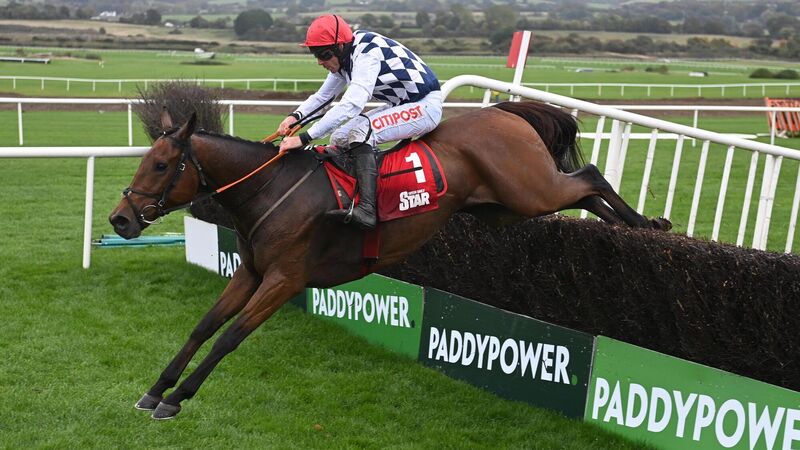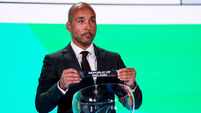Ruby Walsh: Why is racing perennially shocked by small fields at elite level?

ONE OF FIVE: Galvin looks primed to deliver in the Ladbrokes Champion Chase at Down Royal, a race in which he will face just four rivals. Picture: Healy Racing
I get it that everybody has a different view on the shape of life, their sports opinion, and thoughts on what is right or wrong with society. Most people have a take on every subject, but how many of us back that opinion up with facts rather than just the side of a debate we feel most strongly about?
I am not heading off into politics here or going to give an opinion on a war I have no experience of. Instead, I will question those who constantly lament small field sizes at the elite level of horse racing at this time of year.
Firstly, elite's direct meaning is a select group that is superior in terms of ability or qualities to the rest of the group. I don't need the Oxford dictionary to tell me that group will be a tiny portion of the general bunch, otherwise it would not be elite. So why is racing shocked, year after year, when the early season top-level races attract small fields?
Contrary to the perception, this is not a new problem but one that has existed since the creation of the two early season Grade One chases at Haydock and Down Royal in 2005 and 1999 respectively.
The debate around the merit of both races is different because racing needs elite-level horses to promote the sport, just as rugby, soccer, and athletics do. Fans pay to see the best, but, at three-mile, open, Grade One level, how many times can a star run? And perform at its best?
Not as many times as there are races for them. Down Royal to Haydock to Kempton or Leopardstown at Christmas, to the Dublin Racing Festival, Cheltenham, Aintree and Punchestown would be seven races in the season. Not uncommon for novices or handicappers because chances are they won't go the same distance and are likely to have a couple of soft touches. But they don't exist at the top level, and how long do horses last who are raced that often?
Kauto Star — bias aside — is one of the greats at this level, but he never tried the seven — although he did win six in one season. They weren’t six Grade Ones, though, because one was a handicap, and another was only Grade Two against weaker opposition. That was the season of 2006/07, and he tried it again in 2007/08. It wasn't as successful, yielding three wins from six races, his defeats coming in the Old Roan, Gold Cup, and Aintree Bowl.
Paul Nicholls changed tack for the 2008/09 season, where Kauto dominated in his four starts at Down Royal, Haydock Park, Kempton Park, and Cheltenham.
Now nine, he only had three starts in 2009/10, where he was two from three, and four again in 2010/11, where he was one from four before his final season, where he went two from three, winning a fourth Betfair at Haydock and a fifth King George at Kempton.
In his six Gold Cups, 18 lined up in 2007, and the smallest field was in 2010, where 11 faced the starter. No more than six ever joined him facing the starter in his five runs at Haydock, and a high of 13 to a low of seven ran at Kempton. At Down Royal, he ran in a five-runner contest and a seven-runner one and lost a five-runner race at Aintree.
Going back to my debate, since its first renewal Down Royal has never had a double-figure field, with nine in 2020 being the biggest and four in 2003 the smallest. Haydock is similar, with nine in 2014 and four in 2019, and there were four five-runner editions. Since 2000, the Gold Cup has only had fewer than 10 runners twice: nine in 2013 and 2016. Its average field size since 2000 is 13.7, while Down Royal’s since 1999 is 6.3, and Haydock’s since 2005 is 6.2.
Five runners today and five at Haydock in three weeks is just below the average, so what's new?
Personally, I think we have a cracking renewal of the Ladbrokes Champion Chase this afternoon, and with A Plus Tard going to Haydock, L'Homme Presse to Ascot, Galopin des Champs somewhere else, and Bravesmansgame having delivered last week, winners are emerging to make great clashes at Christmas time.
Galvin looks primed to deliver today, but Willie Mullins already has two runs under Kemboy's belt this season, a sign that he thinks today might be his best chance of a big pot with this multiple Grade One-winning 10-year-old.
Henry de Bromhead is changing course with Envoi Allen and going back out in distance to try and spark life into the one-time superstar, and Noel Meade's team are flying so Beacon Edge can't be dismissed. Conflated rounds out the five. The Irish Gold Cup winner has a good record off short breaks but a questionable one off the back of his summer holidays.
The wheels are turning for the National Hunt stars, and the rise to the summit is underway, but whatever you think about the imbalance of the season, it's not a new thing.
In six weeks, we will all know who won the World Cup, but only a few will remember who won each group. Those group games are essential, but they are not the final because every sport builds to something big, and National Hunt racing is no different.
Tennis has four Grand Slams, golf has four Majors, and National Hunt racing has Christmas, the Dublin Racing Festival, Cheltenham, Aintree, and Punchestown. Minnows will down big names in Qatar, as they will through the jumping season, but ultimately who wins at the finals is what will be remembered. That's just life!









